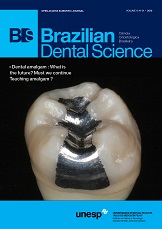Clinical and radiographic outcomes of the use of capping materials in vital pulp therapy of human primary teeth
DOI:
https://doi.org/10.14295/bds.2015.v18i1.1107Abstract
Objective: The aim of this study was to compare the clinical and radiographic outcomes of Calcium Hydroxide (CH), Calcium Hydroxide preceded by corticosteroid/antibiotic solution (O+CH) and diluted formocresol (FC) in the vital pulp therapy of human primary teeth. Material and methods: Forty-five mandibular primary molars of children aged between 5-9 years were randomly assigned in the three study groups, FC, CH and O+CH and received conventional pulpotomy treatment. Clinical and radiographic follow-up was made at 3, 6 and 12-months. Results: No sign of clinical failure was observed in the three study groups during all the periods of evaluation. Radiographic analysis showed a total of six cases of internal root resorption in CH and O+CH groups after the 12 months follow-up, with statistically significant difference as compared with FC group. FC group did not show hard tissue barrier formation, that was observed in CH and O+CH groups in all the follow-up periods. Conclusion: All employed materials showed acceptable clinical and radiographic success rates. The results showed that the use of an anti-inflammatory solution prior the dressing material has therapeutic properties that help with pulpal healing. Continued clinical investigations using these medicaments as vital pulpotomy treatment in primary molars are recommended.
Downloads
Downloads
Published
How to Cite
Issue
Section
License
Brazilian Dental Science uses the Creative Commons (CC-BY 4.0) license, thus preserving the integrity of articles in an open access environment. The journal allows the author to retain publishing rights without restrictions.
=================




























